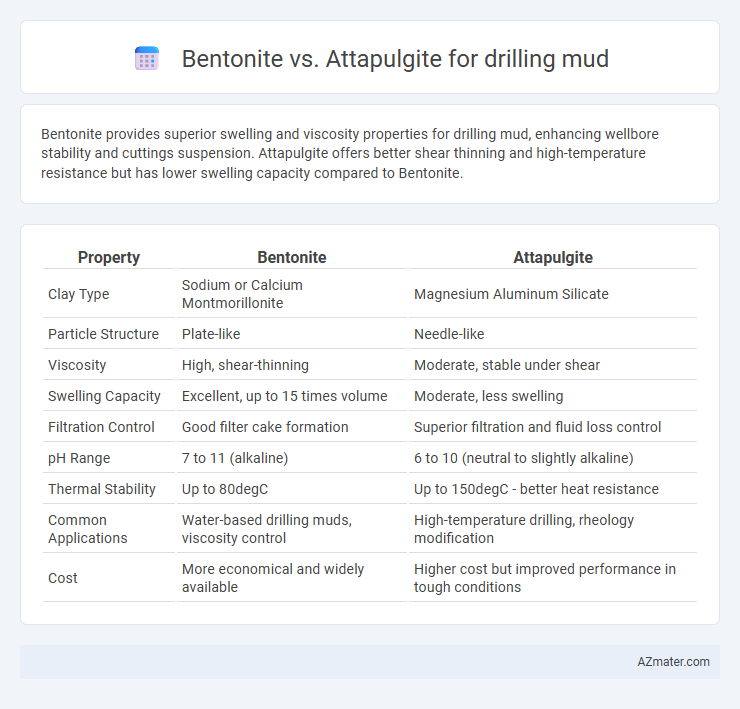Bentonite provides superior swelling and viscosity properties for drilling mud, enhancing wellbore stability and cuttings suspension. Attapulgite offers better shear thinning and high-temperature resistance but has lower swelling capacity compared to Bentonite.
Table of Comparison
| Property | Bentonite | Attapulgite |
|---|---|---|
| Clay Type | Sodium or Calcium Montmorillonite | Magnesium Aluminum Silicate |
| Particle Structure | Plate-like | Needle-like |
| Viscosity | High, shear-thinning | Moderate, stable under shear |
| Swelling Capacity | Excellent, up to 15 times volume | Moderate, less swelling |
| Filtration Control | Good filter cake formation | Superior filtration and fluid loss control |
| pH Range | 7 to 11 (alkaline) | 6 to 10 (neutral to slightly alkaline) |
| Thermal Stability | Up to 80degC | Up to 150degC - better heat resistance |
| Common Applications | Water-based drilling muds, viscosity control | High-temperature drilling, rheology modification |
| Cost | More economical and widely available | Higher cost but improved performance in tough conditions |
Introduction to Drilling Muds
Bentonite and attapulgite are key clay minerals used in drilling mud formulations to enhance rheological properties and fluid loss control. Bentonite, primarily composed of montmorillonite, offers superior swelling and viscosity characteristics, making it ideal for stabilizing boreholes and suspending drill cuttings. Attapulgite, with its fibrous structure, provides excellent thixotropic behavior and thermal stability, beneficial in high-temperature drilling environments.
Overview of Bentonite
Bentonite, a highly absorbent clay primarily composed of montmorillonite, is widely used in drilling mud for its excellent swelling properties and viscosity control, ensuring efficient lubrication and cuttings suspension during drilling operations. It enhances borehole stability by forming a thin, impermeable filter cake that prevents fluid loss and stabilizes well walls. Bentonite's superior hydration capacity and rheological characteristics make it a preferred choice over attapulgite in most drilling applications.
Overview of Attapulgite
Attapulgite, a naturally occurring clay mineral with a fibrous structure, is highly valued in drilling mud for its superior thixotropic properties and excellent suspension capabilities. Unlike Bentonite, which is primarily composed of smectite clay, Attapulgite's unique crystal lattice enhances fluid loss control and viscosity at high temperatures in drilling operations. Its ability to maintain stable rheological properties under diverse conditions makes Attapulgite an essential additive in water-based mud systems for deep and challenging well environments.
Key Properties Comparison
Bentonite and attapulgite are widely used clay minerals in drilling mud, valued for their distinct rheological and filtration properties. Bentonite, primarily composed of montmorillonite, offers superior swelling capacity, high viscosity, and excellent gel strength, making it ideal for stabilizing boreholes and suspending drill cuttings. Attapulgite, characterized by its fibrous structure, provides better thixotropy and filtration control but exhibits lower swelling and viscosity compared to bentonite, influencing its suitability for specific drilling conditions requiring enhanced fluid loss control.
Rheological Performance in Drilling Fluids
Bentonite and Attapulgite differ significantly in their rheological performance when used in drilling mud. Bentonite exhibits superior viscosity and gel strength, providing excellent suspension of drill cuttings and improved hole cleaning efficiency. Attapulgite offers better thermal stability and shear recovery but generally demonstrates lower yield point and gel strength compared to Bentonite, making it suitable for high-temperature drilling conditions with moderate rheological demands.
Filtration Control Capabilities
Bentonite exhibits superior filtration control capabilities in drilling mud due to its high swelling capacity and strong colloidal properties, which create a low-permeability filter cake that minimizes fluid invasion into formation. Attapulgite, while offering better rheological properties and higher temperature stability, generally produces a more permeable filter cake, resulting in less effective filtration control compared to bentonite. The choice between bentonite and attapulgite hinges on balancing filtration control requirements with thermal stability and viscosity characteristics essential for specific drilling conditions.
Suitability in Various Geological Formations
Bentonite demonstrates superior swelling and rheological properties, making it highly effective for stabilizing boreholes in clay-rich and unconsolidated formations. Attapulgite offers enhanced filtration control and thermal stability, proving suitable for high-temperature, fractured, and oil-bearing formations. Selecting between Bentonite and Attapulgite depends on the specific geological conditions, such as formation porosity, temperature, and chemical composition.
Environmental Impact and Safety
Bentonite and attapulgite are both clay minerals used in drilling mud, but bentonite tends to have a lower environmental impact due to its natural abundance and lower toxicity, minimizing groundwater contamination risks. Attapulgite may pose environmental concerns with potential dust generation and higher toxicity, requiring stricter handling protocols to ensure worker safety. In terms of occupational health, bentonite's inert properties reduce respiratory risks compared to attapulgite, which demands enhanced dust control measures to prevent inhalation hazards on drilling sites.
Cost and Availability Analysis
Bentonite is widely preferred in drilling mud applications due to its abundant availability and lower cost compared to attapulgite, making it a cost-effective choice for large-scale operations. Attapulgite offers superior thermal stability and better rheological properties but is less abundant, leading to higher prices and limited supply in certain regions. Evaluating project budgets and regional mineral availability is essential when choosing between bentonite and attapulgite for drilling fluid formulation.
Conclusion: Choosing the Right Clay for Drilling Mud
Bentonite outperforms attapulgite in drilling mud due to its superior swelling capacity and viscosity, providing better wellbore stability and cuttings suspension. Attapulgite offers advantages in high-temperature conditions but generally requires additives to match bentonite's rheological properties. Selecting the right clay depends on the specific drilling environment, with bentonite favored for most applications and attapulgite reserved for specialized thermal or chemical conditions.

Infographic: Bentonite vs Attapulgite for Drilling mud
 azmater.com
azmater.com